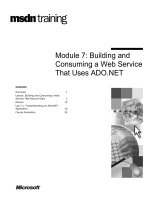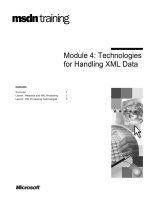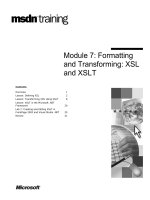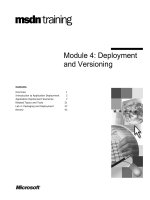Tài liệu Module 4: Designing and Publishing Catalogs ppt
Bạn đang xem bản rút gọn của tài liệu. Xem và tải ngay bản đầy đủ của tài liệu tại đây (1.28 MB, 44 trang )
Contents
Overview 1
Lesson: Introduction to Electronic Catalogs 2
Lesson: Designing Electronic Catalogs 10
Lesson: Publishing Electronic Catalogs 21
Review 32
Lab A: Designing and Publishing Electronic
Catalogs 33
Module 4: Designing
and Publishing Catalogs
Information in this document, including URL and other Internet Web site references, is subject to
change without notice. Unless otherwise noted, the example companies, organizations, products,
domain names, e-mail addresses, logos, people, places, and events depicted herein are fictitious,
and no association with any real company, organization, product, domain name, e-mail address,
logo, person, place or event is intended or should be inferred. Complying with all applicable
copyright laws is the responsibility of the user. Without limiting the rights under copyright, no part
of this document may be reproduced, stored in or introduced into a retrieval system, or transmitted
in any form or by any means (electronic, mechanical, photocopying, recording, or otherwise), or
for any purpose, without the express written permission of Microsoft Corporation.
Microsoft may have patents, patent applications, trademarks, copyrights, or other intellectual
property rights covering subject matter in this document. Except as expressly provided in any
written license agreement from Microsoft, the furnishing of this document does not give you any
license to these patents, trademarks, copyrights, or other intellectual property.
2001 Microsoft Corporation. All rights reserved.
Microsoft, Windows, BackOffice, BizTalk, FrontPage, Hotmail, PowerPoint, Visual Basic,
Visual C++, Visual Studio, and Windows Media are either registered trademarks or trademarks of
Microsoft Corporation in the United States and/or other countries.
The names of actual companies and products mentioned herein may be the trademarks of their
respective owners.
Module 4: Designing and Publishing Catalogs iii
Instructor Notes
This module introduces students to the design, creation, customization,
publishing, and management of electronic catalogs. The goal of students will be
to provide prospective buyers with the right amount of relevant information for
them to make a purchasing decision.
After completing this module, students will be able to:
!
Describe electronic catalog components and schemas.
!
Design an electronic catalog.
!
Publish an electronic catalog to a trading partner.
To teach this module, you require the following materials:
!
Microsoft
®
PowerPoint
®
file 2420A_04.ppt
!
Module 4 demonstration, Publishing and Uploading a Catalog,
2420A_04d005.avi
To prepare for this module:
!
Read all of the materials for this module.
!
Complete the practices and lab.
Presentation:
90 minutes
Lab:
45 minutes
Required materials
Preparation tasks
iv Module 4: Designing and Publishing Catalogs
How to Teach This Module
This section contains information that will help you teach this module.
Lesson: Introduction to Electronic Catalogs
This lesson introduces students to the basic concepts of electronic catalogs. Be
sure that students understand catalog components and schemas before you
discuss design considerations. Although most of the information in this lesson
applies to any type of electronic catalog, the examples assume the use of
Microsoft Commerce Server 2000 catalogs.
The following information is specific to individual pages in this lesson.
Emphasize the difference between the database where catalogs are stored and
the catalog. Make sure that students understand the difference between creating
their catalog from the master content source and transforming it to trading
partner–specific catalogs.
Depending on the experience of your students, this may be review material. The
slide illustrates the five catalog components in Commerce Server 2000 by using
the example of a silver-colored seat for men’s racing bicycles; the colored
boxes on the slide show how the five components describe the seat.
One of the catalog considerations is to provide electronic data interchange
(EDI) compatibility. Although it is possible to translate between EDI and other
schemas, be sure that students understand that Extensible Markup Language
Common Business Library (xCBL) is based on the structure of the American
National Standards Institute (ANSI) X.12 EDI specification and therefore
provides a clear migration or interoperability path for earlier EDI systems.
Lesson: Designing Electronic Catalogs
This lesson introduces students to the skills that they require to maximize their
catalog’s usability. Although a lot of information presented in this lesson, do
not spend too much time on the details. Emphasize the importance of good
catalog design and use negative examples to highlight common mistakes.
The following information is specific to individual pages in this lesson.
Provide real-world examples of good catalogs that follow the four design
guidelines. More importantly, provide examples of poorly designed catalogs
where buyer analysis has obviously not occurred.
Even though you have mentioned the graphical user interface (GUI) and
application programming interface (API) earlier in the module, this is where
you should describe how to use these methods. If you choose to install
Commerce Server for demonstration purposes, demonstrate the interfaces here.
Have students draw their suggested catalog hierarchies on a white board. The
proposed answer in the Instructor Manual is only one possible solution. Be
prepared to discuss differences in students’ assumptions. Important
considerations include: the buyer’s knowledge of bicycle parts, simplicity of the
catalog structure, and the buyer’s likely browsing strategy. Be sure that students
can justify their category designs.
Overview of Catalog
Design and Publishing
Components of a
Catalog
Considerations for
Choosing a Catalog
Schema
How to Determine
Catalo
g Content
Methods for Creating
Catalogs
Practice
Module 4: Designing and Publishing Catalogs v
Lesson: Publishing Electronic Catalogs
This lesson describes how to transform the catalog to a trading partner’s
schema, publish it securely to the trading partner, and then manage updates to
the trading partner’s catalog.
The following information is specific to individual pages in this lesson.
Many of the considerations for transporting and securing catalogs are the same
as transporting any other document. Mention that you will revisit these
considerations in Module 5, Processing Orders, when you cover transporting
purchase orders.
Catalog size restrictions are a significant limitation to suppliers. One method for
addressing this limitation is remote shopping. Avoid discussing details on
remote shopping here. Mention that you will cover remote shopping in
Module 6.
Lab: Designing and Publishing Electronic Catalogs
In this lab, students will assess their trading partners’ requirements for product
information. Then, they will decide on the structure and format of the catalogs
and how to deliver the catalogs electronically to their trading partners. Be sure
that the student teams are making progress to the end design as they work in
their design teams.
The design lab is scheduled for 45 minutes. Divide students into pairs or small
teams, and ask them to spend 20 minutes reading and discussing the scenario.
Then, have each pair or team present its answers to the class.
Students will examine Adventure Works’s business drivers and motivations for
engaging in business-to-business (B2B) e-commerce and for using a
marketplace. Although the lab scenario provides a clear path to certain design
decisions, it contains enough ambiguity to encourage student discussion and
debate. Students may disagree with the answers that are provided in the
Delivery Guide.
For more information about Content Management Server 2001 and Commerce
Server 2000, see the Microsoft Content Management Server Web site at
and the Student
Materials compact disc. Disagreement is acceptable if students can provide
adequate business or technical justification. To increase student involvement,
ask a representative of each team to present the team’s answers to the class and
then defend the design.
Considerations for
Choosing a Transport
Protocol
Methods for Managing
Catalog Size
Timing
Discussion
vi Module 4: Designing and Publishing Catalogs
Customization Information
This section identifies the lab setup requirements for a module and the
configuration changes that occur on student computers during the labs. This
information is provided to assist you in replicating or customizing Microsoft
Official Curriculum (MOC) courseware.
This module contains a single paper-based design lab. There are no hands-on
labs in this module, and as a result, there are no lab setup requirements or
configuration changes that affect replication or customization.
Module 4: Designing and Publishing Catalogs 1
Overview
!
Introduction to Electronic Catalogs
!
Designing Electronic Catalogs
!
Publishing Electronic Catalogs
Trading
Partner
Trading
Trading
Partner
Partner
PO
Supplier
Supplier
Master
Content
Source
Master
Master
Content
Content
Source
Source
Catalog
Management
Catalog
Management
*****************************
ILLEGAL FOR NON
-
TRAINER USE
******************************
As a supplier, you want to provide your trading partners with detailed
information about your products or services. Traditionally, suppliers have used
paper-based catalogs that contain organized lists of products and descriptive
information or illustrations.
Likewise, in business-to-business (B2B) e-commerce, suppliers organize their
product information in catalogs. However, instead of using paper catalogs,
suppliers use a digital format, called an electronic catalog, to create, organize,
and maintain their product information.
To be successful in B2B e-commerce, suppliers must design accurate and
informative electronic catalogs and publish those catalogs to their trading
partners.
After completing this module, you will be able to:
!
Describe electronic catalog components and schemas.
!
Design an electronic catalog.
!
Publish an electronic catalog to your trading partner.
Introduction
Ob
jectives
2 Module 4: Designing and Publishing Catalogs
Lesson: Introduction to Electronic Catalogs
!
Overview of Catalog Design and Publishing
!
Components of a Catalog
!
Types of Catalog Schemas
!
Considerations for Choosing a Catalog Schema
*****************************
ILLEGAL FOR NON
-
TRAINER USE
******************************
Whether you design a paper-based catalog or an electronic catalog, you must
organize product information in logical product groups so that buyers can find
the information that they need. Knowledge of catalog components and schemas
enables you to design electronic catalogs that are complete, organized, and
compatible with your trading partners.
After completing this lesson, you will be able to:
!
Describe the process of catalog design and publishing.
!
Describe the components of an electronic catalog.
!
Describe the different types of catalog schemas.
!
Choose an appropriate catalog schema.
Introduction
Lesson ob
jectives
Module 4: Designing and Publishing Catalogs 3
Overview of Catalog Design and Publishing
Master Content
Source
Catalog in
Your
XML Schema
Catalog in
Trading Partner’s
XML Schema
Publish
Publish
Publish
Transform
Transform
Transform
Trading
Partner’s
Catalog
Publish the catalog:
" Transport protocol
" Security method
Create
Create
Create
1
1
1
2
2
2
3
3
3
Create a catalog:
" Categories
" Attributes
Transform the catalog:
" Transformation method
" Restructure categories
*****************************
ILLEGAL FOR NON
-
TRAINER USE
******************************
Making product information available to trading partners requires several steps.
Using the data in your master content source, you must create, transform, and
publish your product catalog to your trading partner.
Designing and publishing electronic catalogs involves the following steps:
1. Create a catalog. Develop a categorization structure for your catalog. Then,
using product information from your master content source, select and
populate the attributes in your catalog.
2. Transform the catalog. Select a transformation method and transform your
catalog to your trading partner’s Extensible Markup Language (XML)
catalog schema. Because of differences in catalog schemas, you may need to
restructure the categories in your catalog during transformation.
3. Publish the catalog. Finally, publish the transformed catalog to your trading
partner. You must choose the appropriate transport protocol and security
method before publishing the transformed catalog to your trading partner.
Introduction
Steps of designing and
publishing a catalog
4 Module 4: Designing and Publishing Catalogs
Components of a Catalog
Product variant
Product
Attribute
Value
Category
Bicycle Parts
Catalog
Women’s racing seat
011246 Black
Brakes
Seats
Seats
SKU
SKU
Color
Color
011245
011245
Silver
Silver
Color
Color
Men’s racing seat
Men’s racing seat
SKU Color
*****************************
ILLEGAL FOR NON
-
TRAINER USE
******************************
A catalog is a list of products and product information that is organized
hierarchically. The hierarchies help you gather and present your product
information in a meaningful way.
You use catalog components to describe your products. You may use several
different components to describe a single product. A Microsoft
®
Commerce
Server 2000 catalog uses the following five catalog components:
!
Categories. Groups of related products or other categories. Categories
simplify browsing and make catalogs more usable for buyers. For example,
you can create a category called Seats that contains every style of bicycle
seat. You can also create categories that contain other categories. For
example, you can create two top-level categories called Men’s Accessories
and Women’s Accessories. Each contains its own hierarchy of product
categories.
!
Products. A discrete offering of a product or service. In an electronic
catalog, most products are uniquely represented by a Stock Keeping Unit
(SKU) value. For example, if you offer two racing seats, a women’s racing
seat and a men’s racing seat, your catalog will include a product definition
for each product.
!
Product variants. A small difference between products. For example, your
catalog offers a men’s bicycle seat in six colors. Instead of defining six
products, you can define a single product with six product variants.
Introduction
Catalo
g components
Module 4: Designing and Publishing Catalogs 5
!
Attributes. The specific qualities of products in a catalog. Attributes define
physical descriptors, such as color, height, and weight. They also define
dynamic elements, such as inventory levels, and related information, such as
the relative path for the electronic image of the product.
!
Values. Data that populates the attribute field of a product. For example, one
attribute of a men’s racing bicycle seat is color. In the preceding slide, the
value of that attribute is silver.
The Commerce Server 2000 schema supports five catalog components.
Other catalog schemas may implement these categories and product variants
differently.
Note
6 Module 4: Designing and Publishing Catalogs
Types of Catalog Schemas
Catalog schemas
Catalog schemas
Catalog schemas
Description
Description
Description
Commerce Server
2000
Commerce Server
2000
" Default catalog schema in Commerce Server 2000
" Flexible catalog creation and management
" Default catalog schema in Commerce Server 2000
" Flexible catalog creation and management
cXML
cXML
" Developed by Ariba
" Widely supported by marketplaces
" Strong support for remote shopping
" Developed by Ariba
" Widely supported by marketplaces
" Strong support for remote shopping
xCBL
xCBL
" Developed by Commerce One
" Based on EDI document structures
" Uses ISO standards for attributes
" Developed by Commerce One
" Based on EDI document structures
" Uses ISO standards for attributes
Other XML schemas
Other XML schemas
" Industry-standard schemas, such as RosettaNet
" Custom schemas for specific trading partners
" Flat file catalogs
" Industry-standard schemas, such as RosettaNet
" Custom schemas for specific trading partners
" Flat file catalogs
*****************************
ILLEGAL FOR NON
-
TRAINER USE
******************************
The catalog schema determines the structure of the catalog and the definitions
of products. Organizations typically format their electronic catalogs in some
variation of XML.
You can format your catalog in any of the following XML schemas:
!
Commerce Server 2000. Commerce Server has its own default catalog
schema. The same catalog schema that is used in business-to-consumer
(B2C) Web sites with Commerce Server can be used for B2B Web sites.
You can create and manage catalogs in Commerce Server either through the
graphical user interface (GUI) or programmatically through an application
programming interface (API). An updated catalog schema is included in
Commerce Server 2000 Service Pack 1.
!
Commerce XML (cXML). A set of XML business documents designed to
facilitate communication between applications. Ariba, Inc. created cXML
and licensed it for public use. cXML supports an implementation of remote
shopping called PunchOut. cXML is used by marketplaces such as Ariba,
Inc., Clarus, Inc., and VerticalNet, Inc.
You can download the catalog schema for cXML from the cXML
Web site at .
Introduction
Types of catalog
schemas
Note
Module 4: Designing and Publishing Catalogs 7
!
XML Common Business Library (xCBL). xCBL is a set of XML business
documents that were created by Commerce One, Inc. and modeled after the
electronic data interchange (EDI) standards American National Standards
Institute (ANSI) X.12 and Electronic Data Interchange for Administration,
Commerce and Transport (EDIFACT). Organizations use xCBL to preserve
and use existing EDI investments by providing a clear migration path from
EDI to XML. In addition, xCBL facilitates e-commerce transactions for
organizations that have not implemented EDI. Release 2 of xCBL 3.0
includes three types of schemas: document type definition (DTD), Schema
for Object-Oriented XML (SOX), and XML Data Reduced (XDR). The
xCBL library of business documents strictly follows International
Organization for Standardization (ISO) standards.
You can download the catalog schema for xCBL from the xCBL Web
site at .
!
Other XML schemas. Your organization may choose an industry-standard
set of business documents, such as RosettaNet, that has its own schema for
describing products. You or your trading partner may have business systems
that require a custom catalog schema. For example, to conform to your
trading partner’s legacy systems, you may choose a common flat file format
for your catalog.
Even though two organizations implement the same XML schema,
the implementation of those schemas may differ. As a result, you must verify
how each trading partner uses the XML schema and what, if any, extensions it
has made.
Note
Im
portant
8 Module 4: Designing and Publishing Catalogs
Considerations for Choosing a Catalog Schema
Catalog considerations
Catalog considerations
Catalog considerations
Operate a Commerce Server 2000
Web site
Operate a Commerce Server 2000
Web site
Manage catalog through a graphical
user interface
Manage catalog through a graphical
user interface
Manage catalog through an API
Manage catalog through an API
Support incremental updates
Support incremental updates
Commerce
Server
2000
Commerce
Commerce
Server
Server
2000
2000
cXML
cXML
cXML
xCBL
xCBL
xCBL
Custom
XML or
flat file
Custom
Custom
XML or
XML or
flat file
flat file
Use a single set of XML business
documents
Use a single set of XML business
documents
Provide EDI compatibility
Provide EDI compatibility
Respond to industry or regulatory
standards
Respond to industry or regulatory
standards
*****************************
ILLEGAL FOR NON
-
TRAINER USE
******************************
Select the most appropriate catalog schema before importing product
information from the master content source. Your choice of a catalog schema
depends on several business and technical considerations. If you use the
Commerce Server 2000 catalog schema for your B2C Web site, your
organization will likely use the same catalog schema for its B2B Web site.
However, some specific business considerations may cause you to choose a
different schema.
Several business and technical business considerations will determine your best
choice of catalog schema:
!
Commerce Server. If you currently use Commerce Server to host your
e-commerce Web site, use the Commerce Server catalog schema. You can
use Commerce Server to create and manage catalogs. The catalog schema in
Commerce Server 2000 Service Pack 1 supports incremental updates at the
product level to published catalogs.
!
cXML. A B2B schema definition, xCML provides extensive support for
remote shopping and supports incremental updates at the product and
attribute levels.
!
xCBL. If you are integrating with legacy EDI systems, consider using the
xCBL catalog schema. xCBL is based on the structure of EDI X.12 and
EDIFACT documents and has extensive support for incremental updates at
the product and attribute levels, including support for dynamic pricing.
!
Custom XML or flat file. Your industry may require a specific set of
schemas for business documents. For example, much of the computer
technology industry uses RosettaNet, and the health care industry requires
the Health Insurance Portability and Accountability Act (HIPAA) schema.
If your organization has a large investment in legacy infrastructure, such as
customized EDI systems, consider creating a customized schema for
catalogs in either XML or flat file format.
Introduction
Catalog schema
considerations
Module 4: Designing and Publishing Catalogs 9
For information about using Microsoft BizTalk
™
Server 2000 to integrate
RosettaNet with business systems, see the BizTalk Server Web site at
For more information about using BizTalk Server for HIPAA compliance, see
the BizTalk Server Web site at
Note
10 Module 4: Designing and Publishing Catalogs
Lesson: Designing Electronic Catalogs
!
How to Determine Catalog Content
!
Considerations for Designing Catalog Structure
!
Guidelines for Creating Categories
!
Guidelines for Designing Catalogs
!
Methods for Creating Catalogs
!
Practice: Designing a Catalog Structure
*****************************
ILLEGAL FOR NON
-
TRAINER USE
******************************
When you create electronic catalogs, your goal is to maximize the catalog’s
usability and provide your buyers with all of the relevant information that they
require to make an informed purchase. Each trading partner has unique needs
and may require that its catalog be in a specific format or contain customized
product information. Therefore, you may need to create a separate catalog for
each trading partner.
After completing this lesson, you will be able to:
!
Determine what content to include in your catalog.
!
Design the structure of the categories in your catalog.
!
Create the categories for your catalog.
!
Design your catalog.
!
Create your catalog by using Commerce Server.
Introduction
Lesson ob
jectives
Module 4: Designing and Publishing Catalogs 11
How to Determine Catalog Content
Determine the buyer’s job role
Determine the buyer’s job role
Assess the buyer’s familiarity with products
Assess the buyer’s familiarity with products
Analyze the competitors’ catalogs
Analyze the competitors’ catalogs
Determine the buyer’s information needs
Determine the buyer’s information needs
When determining catalog content:
When determining catalog content:
When determining catalog content:
*****************************
ILLEGAL FOR NON
-
TRAINER USE
******************************
Your master content source contains detailed information about your products
or services. However, your buyers will be interested in only some of that
content. Systematic buyer analysis is the most important factor in defining the
correct content to include in each catalog.
Use the following steps to determine the content of each catalog:
1. Determine the buyer’s job role. Examine the job function of the person in
your buyer’s organization who will make the purchase decision. Knowledge
of the buyer profile will help you determine how best to describe your
products. For example, you may determine that buyers from different job
roles, such as engineers and purchasing agents, purchase from your catalogs.
2. Determine the buyer’s information needs. Some buyers require detailed
technical information before they purchase a product; other buyers require
only general descriptions. Also, determine the product information that your
buyers do not need or want to know. For example, computer suppliers may
serve two distinct buyer profiles: engineers and purchasing agents.
Engineers may require detailed technical information about memory and
performance before making an informed purchase, whereas purchasing
agents may require warranty and compatibility information.
3. Assess the buyer’s familiarity with products. Buyers who are familiar with
your product or industry have different needs for product information. For
example, an engineer with extensive computer experience may not require
information about a computer’s ability to run specific software packages,
whereas a purchasing agent may require that information.
4. Analyze the competitors’ catalogs. Your buyers will almost certainly
compare your product offerings with those of your competitors. For
example, if one of your competitors includes attributes that describe their
warranty period but your catalog does not, buyers may choose the
competitor’s products even though you offer better warranties.
Introduction
Steps in determining
catalog content









